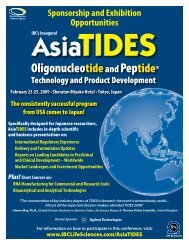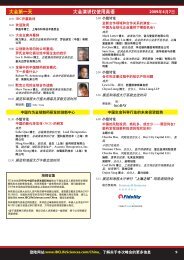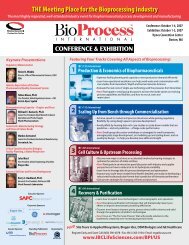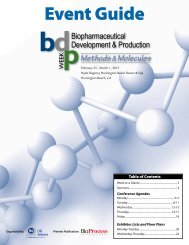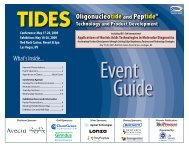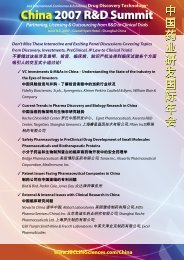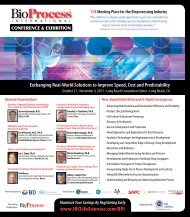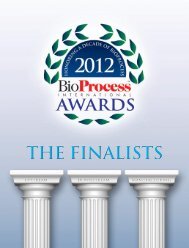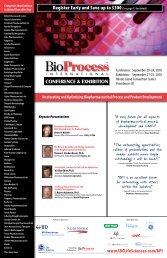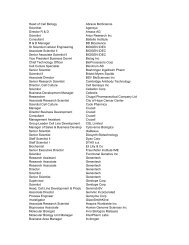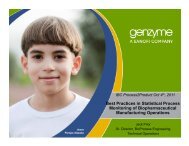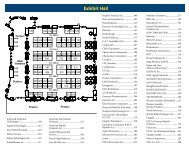Cell Culture & Upstream Processing - IBC Life Sciences
Cell Culture & Upstream Processing - IBC Life Sciences
Cell Culture & Upstream Processing - IBC Life Sciences
You also want an ePaper? Increase the reach of your titles
YUMPU automatically turns print PDFs into web optimized ePapers that Google loves.
3<br />
Friday, September 26, 2008 • Main Conference (continued)<br />
<strong>Cell</strong> <strong>Culture</strong> & <strong>Upstream</strong> <strong>Processing</strong><br />
1:30 Chairperson’s Remarks<br />
Thomas Seewoester, Ph.D., Director, Process Development, Amgen Inc.<br />
Impact of <strong>Upstream</strong> Advances on Downstream<br />
<strong>Processing</strong> and Product Quality –<br />
Act Locally but Think Globally<br />
1:45 Achieving 10+ Grams per Liter – Challenges in<br />
Process Development<br />
Effective development of a high-titer process 'platform' is greatly facilitated by an<br />
integrated, multifaceted approach. Technological advances beginning as early as<br />
molecular selection, and encompassing all aspects of cell culture and purification<br />
process design afford tremendous opportunity to both enhance performance<br />
and to assist in ready transfer, scale-up and implementation. Examples will be<br />
provided to illustrate the benefits of having a comprehensive toolkit of cuttingedge<br />
process options in achieving transformational production performance.<br />
Timothy S. Charlebois, Ph.D., Senior Director, Drug Substance Development,<br />
Wyeth BioPharma<br />
2:15 Different Development Paths to Higher Productivity and<br />
Improved Quality<br />
<strong>Cell</strong> culture improvements may be obtained through multiple paths. A strategic<br />
improvement plan could include the examination of expression technologies,<br />
host cell selection, cell line development, media development and bioreactor<br />
operations. Most organizations must prioritize cell culture improvement activities<br />
to achieve a balance of both short-term and long-term benefits. This presentation<br />
examines the different aspects of cell culture improvement, providing a high level<br />
understanding of the complexity and benefits of the various initiatives.<br />
Gary Welch, Director, Process Development, Abbott Bioresearch Center<br />
2:45 The Impact of Sequence on Product Attributes and<br />
Process Outcome<br />
Similarities among monoclonal antibodies have enabled the implementation<br />
of efficient platform process development procedures leading to dramatically<br />
shortened process development timelines. Our diversified portfolio at Wyeth<br />
includes antibodies, Fc-fusion proteins and smaller, simpler, non glycosylated<br />
molecules. This talk will illustrate how the choice of product type and sequence<br />
can significantly impact the process development options and outcome.<br />
Martin Allen, Ph.D., Principal Research Scientist, <strong>Cell</strong> and Molecular <strong>Sciences</strong>,<br />
Wyeth BioPharma<br />
3:15 Networking Refreshment Break<br />
Overcoming Manufacturing Issues<br />
3:30 Avoiding Pitfalls in Quality by Design CASE<br />
Quality by Design (QbD) techniques have proven effective in evaluation<br />
STUDY<br />
and understanding of biologics manufacturing processes including identification<br />
of CQA’s and COP’s. However, there are pitfalls in the application of QbD<br />
techniques that can mislead the identification of “Design Space” with<br />
consequences for manufacturing control and consistency. In this presentation,<br />
examples will be used to illustrate best practices to avoid pitfalls in QbD.<br />
Graham McCreath, Ph.D., Senior Scientist, Avecia Biologics Limited, United Kingdom<br />
Mahesh Shivhare, Statistician, R&D, Avecia Biologics Limited, United Kingdom<br />
4:00 Towards More Modular, Compact, and Cost Effective<br />
Manufacturing Facilities: Combining the Latest Advances in<br />
Process Development with Bioreactor Technology Development<br />
We have successfully completed implementation of a fully disposable cell culture<br />
platform, both in development and in cGMP clinical manufacturing suites. This<br />
disposable platform encompasses media and harvest storage, cell expansion in<br />
preculture and seed bioreactors, and production bioreactors. This disposable platform<br />
is capable of making clinical and commercial supplies. We will share our experience<br />
with the disposable systems, discuss the design and implementation challenges, and<br />
elaborate on how disposable platforms can change the future of cell culture processes.<br />
Sadettin Ozturk, Ph.D., Head, Bioprocess Technology, Centocor R&D<br />
4:30 Impact of Impeller Design on Antibody Production<br />
CASE<br />
by Chinese Hamster Ovary <strong>Cell</strong>s<br />
STUDY<br />
Large scale production of monoclonal antibodies has been accomplished using<br />
bioreactors with different length to diameter ratios, and diverse impeller and sparger<br />
designs. The differences in these physical attributes could result in dissimilar mass<br />
transfer, shear dynamics and mixing inside the bioreactor, which could lead to disparities<br />
in cell growth, antibody production and final product quality. The purpose of this study is<br />
to understand the impact of impeller designs on process and culture parameters.<br />
Sandeepa Sandadi, Scientist II, Biological & Sterile Product Development,<br />
Schering-Plough Research Institute<br />
5:00 Close of BPI 2008<br />
4<br />
Recovery & Purification<br />
1:30 Chairperson’s Remarks<br />
Adam Goldstein, M.S., Senior Manager, Oceanside Clinical Operations,<br />
Genentech, Inc.<br />
Protein A and Beyond<br />
1:45 Considerations for the Optimization of the Protein A<br />
Capture Step in Antibody Processes<br />
Abstract not available at press date.<br />
Please visit www.<strong>IBC</strong><strong>Life</strong><strong>Sciences</strong>.com/BPI/US for updates.<br />
Sanchayita Ghose, Ph.D., Manager, Process <strong>Sciences</strong> Downstream,<br />
Bristol-Myers Squibb<br />
2:15 Development and Scale Up of Q Membrane<br />
CASE<br />
Chromatography in Non-Affinity Purification<br />
STUDY<br />
Processes of HuMAbs<br />
Disposable membrane chromatography has been successful in replacing resin<br />
flowthrough chromatography and provides an efficient viral removal strategy<br />
for non-affinity purification processes of HuMAbs. Scaleability of membrane<br />
application has been tested up to 350 and 200L bioreactors to process harvests<br />
for different molecules. Loading capabilities on this single use chromatography<br />
were increased up to 10g/L to positively impact process economics without<br />
compromising viral clearance capability. HuMAbs case studies will be described.<br />
Gisela M. Ferreira, Ph.D., Senior Process Engineer, Purification Process<br />
Development, Medarex Inc.<br />
2:45 Reduction of Host <strong>Cell</strong> DNA Using Charged Filters at<br />
Protein A Capture for Monoclonal Antibody Production<br />
One of the products generated by perfusion cell culture at Centocor had higher<br />
than usual host cell DNA (~20 ug/mL) in the harvest. Bench-scale studies (~ 10<br />
liters) were performed using various positively charged depth filters to reduce the<br />
host cell DNA level. These filters were placed in-line during loading harvest onto<br />
the Protein A column. The CUNO charged filter 120ZA10A EXT was found to<br />
reduce the DNA by greater than 1 log when processing at 220 L of harvest/m2.<br />
John Wesner, Associate Scientist, Development Pilot Plant, Centocor R&D<br />
3:15 Networking Refreshment Break<br />
Improving Downstream Economies and Efficiencies<br />
Using Disposables in Chromatography<br />
3:30 Disposable Applications in Antibody Purification<br />
New advances in disposable technologies are creating a wider range for single-use systems<br />
in the upstream and downstream processing arenas, including cell-culture bioreactors,<br />
formulation and filling applications, new mixing technology, and disposable depth<br />
filters used in harvesting equipment. This talk will examine the development of recent<br />
improvements in the production of bulk antibodies. The benefits and limitations of these<br />
applications will be presented including the application of a new design for frozen bulk.<br />
Adam Goldstein, M.S., Senior Manager, Oceanside Clinical Operations, Genentech, Inc.<br />
4:00 Effective Incorporation of Disposables into mAb Drug<br />
Substance Production<br />
In this presentation, the incorporation or implementation of three disposable<br />
systems such as depth filtration, membrane chromatography, and nanometer<br />
filtration technology in first-in-human and commercial processes will be introduced.<br />
Integration of disposable systems into an existing process will be examined and<br />
an excellent data set of impurity removal and viral clearance will be presented.<br />
Advantages and disadvantages including cost analysis, validation and facility usage will<br />
be discussed. Possible future disposable systems such as mix mode membranes and<br />
monoliths in 2-column downstream purification will be further discussed.<br />
Joe Zhou, Ph.D., Scientific Director, Process Development, Amgen Inc.<br />
4:30 Minimizing Buffer Storage Requirements for Antibody<br />
Purification in High Titer Processes: Integration of<br />
Inline Dilution, Disposable Technology and Optimized<br />
Buffer Preparation<br />
A case study will be presented that illustrates how inline dilution of buffer concentrates<br />
and large volume disposable bag technology can be integrated, to effectively eliminate<br />
buffer capacity bottlenecks, significantly reduce the required tankage volume and<br />
introduce flexibility. Approaches to further reducing total volume requirements in<br />
buffer preparation and optimizing solids handling will also be discussed, together with<br />
select examples of challenges encountered as a 25,000 L mammalian cell culture facility<br />
employing these new technologies was brought online.<br />
Mark Smith, Ph.D., Process Support Engineer, Genentech, Inc.<br />
5:00 Close of BPI 2008<br />
Visit www.<strong>IBC</strong><strong>Life</strong><strong>Sciences</strong>.com/BPI/US for up-to-date information on this event 17





